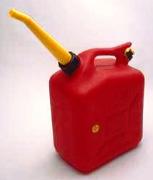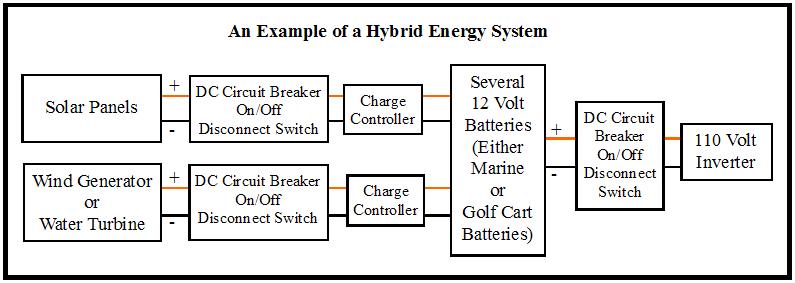<
















Alternate Energy Sources
Copyright © November 1, 2011 by Robert Wayne Atkins, P.E.
All Rights Reserved.
 During serious hard times you may not be able to consistently depend on traditional sources of energy. Electrical power may become intermittent, or it may be rationed to a few hours each day in each area, or the power may fluctuate to extremes that will damage or destroy your electrical equipment and appliances. In situations such as these it would be nice if your family had an alternate energy source that you could depend on.
During serious hard times you may not be able to consistently depend on traditional sources of energy. Electrical power may become intermittent, or it may be rationed to a few hours each day in each area, or the power may fluctuate to extremes that will damage or destroy your electrical equipment and appliances. In situations such as these it would be nice if your family had an alternate energy source that you could depend on.
In the past mankind has been able to harness the power of the wind and the power of flowing water to make his jobs easier and to make him more productive. Today mankind has created windmills and water turbines that can convert the power of the wind and the power of flowing water into electricity, and then use that electricity to make his jobs easier and to make him more productive. Mankind has also figured out how to convert the sun's energy into electricity.
Today a family may produce electricity on a small scale using the sun, the wind, or water. This article will discuss solar power and wind power and water power in order to help you determine whether or not one of these options would be feasible for your family in your specific circumstances.
Although I have mentioned it before in several of my other articles, if you only need to recharge flashlight batteries then you only need a small solar panel similar to the one described in my article on Rechargeable Batteries and a Solar Battery Charger.
A Gasoline Generator
Before we examine solar, wind, and water power let's first take a look at a gasoline (or propane) powered generator.
The advantages of a gasoline generator:
- It is a very practical alternative when there is a short-term interruption in the delivery of your utilities, such as during a serious wind storm, or rain storm, or snow storm when the utility lines may be knocked down or disabled for a variety of reasons.
- After a gasoline generator has been safely and correctly wired to your home electrical system, with the appropriate disconnect to protect utility workers who are repairing the electrical lines, then you can throw the switch that disconnects you from the local utility grid and connects your house to your generator, and then activate your generator and your house will now have power.
- A gasoline generator does not require you to manage a backup energy system that contains a bank of 12-volt batteries.
The disadvantages of a gasoline generator:

- A gasoline generator is a little louder than the average lawn mower. Therefore when it is in operation anyone within hearing range will know that you have power and they do not.
- A gasoline generator emits poisonous carbon monoxide fumes that can kill people and pets. This means the generator may not be located inside your home or in your garage. It must be located outside in a well-ventilated area. It cannot be near a window air conditioning unit because the fumes will enter the house quickly if the air conditioner is running and slowly if the air conditioner is off. It cannot be located near an eve or gable of a house that contains an open space into your attic that is only protected by a narrow mesh wire grate to keep birds and rodents out. The fumes will enter your attic and gradually enter your living area through the small openings in your overhead light fixtures and ventilation ducks. If you are aware of these potential life-threatening issues then you can easily locate your generator where there is no possibility of the poisonous fumes making your family sick (or killing your family members).
- A gasoline generator needs to have its oil and oil filter changed on a periodic basis. This is not hard to do but it needs to be done. When you are ready to install a new oil filter you should install it the same way you would on your vehicle. Put a little clean oil on the tip of your finger and then spread that oil around the threads on the oil filter, and around the gasket on the oil filter, and around the metal surface on the oil filter that will be making contact with your generator. This will help to create a better seal when you install the oil filter and later it will make it easier when you have to remove that oil filter to replace it.
- A gasoline generator will not work without gasoline. Therefore you must be able to replenish your gasoline as you consume it. During power outages the gas stations are also frequently without power and therefore their pumps don't work. This means you can't replenish your gasoline at a gas station that is near to you.
- A gasoline generator will run between 2 hours to 2.5 hours on one gallon of gas. This means you will need somewhere between ten to twelve gallons of gasoline per day to keep your generator running.
- The cost of gasoline to keep a generator running for one day will be about $35 or more in gasoline (ten gallons multiplied by $3.50 per gallon of gasoline). This would be $245 per week, or $1,050 per month, or $12,775 per year. Therefore a gasoline (or propane) generator is not a financially economical solution for a long-term power outage.
- Gasoline is flammable and it must be stored in a safe area away from your home.
- A gasoline generator must be turned on once per month and allowed to run for at least 30-minutes to keep the internal engine parts lubricated with oil. This will also prevent the gasoline from hardening inside the fuel lines and preventing the fuel from reaching the engine. When you are running your generator it should be connected to a reasonable load, such as your home, to put a load on its internal electrical components.
- A gasoline generator should have a battery-start system in addition to a pull-start system. If you run your generator once a month then you will also be able to keep your 12-volt battery charged.
The above discussion was not intended to be a recommendation for or against a gasoline generator. The purpose of the above information was to provide you with the appropriate facts about gasoline generators so you could make the decision on whether or not to invest in one.
In my opinion, gasoline (or propane) generators are nice things to have during short-term power outages because they will allow a family to keep the food in their refrigerator and freezer from going bad. However, during a long-term power outage there are more economical ways to generate power for your home.
Now let's take a look at some other options for generating power.
A Hybrid Energy System
A hybrid system for producing electricity will include any two or all three of the following:
1. Solar Panels.
2. Windmill (or Wind Generator).
3. Water Turbine.
In addition to the above a hybrid system must also include the following components:
1. Marine or Golf Cart Deep Cycle Batteries.
2. Charge Controllers to prevent overcharging of the batteries.
3. Inverter to convert 12 volt battery power into 110 volt house power and to protect the batteries from being seriously discharged.
4. DC Circuit Breaker On/Off Disconnect Switches that automatically disconnects the system in the event of power overloads, and they also allow you to manually disconnect the system for any reason if you so desire.
If you install your hybrid energy system so that it connects directly to your home's existing electrical lines, then you must install a disconnect switch that will disconnect your home from the county electrical grid at the same time that it connects your hybrid energy system to your home.
On the other hand, if you simply run one or more electrical extension cords from your 110-volt inverter to specific appliances in your home, such as your refrigerator and television as examples, then you will not need to disconnect your home from the county utility grid.

Battery Maintenance
All hybrid energy systems require a bank of 12-volt deep cycle batteries. If your hybrid energy system is in regular use then your batteries will be charged and discharged on a regular basis. However, if you are not using your hybrid energy system, your batteries will still gradually discharge at a very slow rate.
It is important to allow your batteries to discharge to their safe minimum discharge level about once a month (or at least once every two months). If you have an inverter then the inverter should have an automatic low-battery disconnect circuit that will stop drawing energy from your batteries when your batteries reach their safe minimum discharge level. When that happens you should temporarily disconnect the inverter and then charge your batteries to their maximum safe level and hold them there for about one-hour. This will allow your batteries to cleanse themselves. Then you can start using your batteries again in a normal fashion for another month or two. If you will take care of your batteries then they will last about five to seven years before they need to be replaced.
Voltage Considerations
It is possible to design a system as 12 volts, 24 volts, of 48 volts. However the 12 volt system will probably be the best choice for most families. The reason is simple. You can use standard 12 volt deep cycle batteries (marine or golf cart) without having to connect them together to increase their voltage. This means if one battery expires then you can simply remove it and the rest of your batteries will continue to work as expected. However, if you put two batteries together to make 24 volts and one of them expires then you also have to remove the other battery. If you put four batteries together to make 48 volts and one of them expires then you will also have to remove the three other batteries.
Having a 12 volt system will also allow you to more easily design a hybrid energy system that uses some combination of solar, wind, and/or water. Having a hybrid energy system is a significant advantage because it provides a family with more than one method for producing electricity.
For example, a hybrid system could consist of solar panels and a windmill. On a bright sunny day you may have no wind but your solar panels will be producing energy reliably. On a cloudy overcast day your solar panels may only generate a trivial amount of electricity but if the wind is blowing then the wind will be producing a significant amount of electricity. Or if it is raining and the wind is blowing then you will still be able to produce electricity using the wind. And at night when the sun is not shining you may still be able to produce electricity using wind power. Therefore a hybrid system would be preferred to a system that only depended on one source of power.
Solar Power
 Solar power is probably the best choice for most families for the following reasons:
Solar power is probably the best choice for most families for the following reasons:
- Solar power may be used anywhere the sun shines.
- Solar power is silent.
- Solar panels do not require any regular maintenance or replacement parts. Most solar panels have a rated life of between 12 to 20 years or more. As a solar panel is used it gradually becomes a little less efficient each year. At the end of 15 years the solar panel may only produce 50% or 60% of the solar power that it produced when it was new but it will still be producing some energy to recharge your batteries.
- Solar panels may be connected to one another and to the entire solar power system using red and black wires.
- If your solar panels are small then you may disconnect them and bring them indoors at night, and during bad weather, to protect them from any type of damage and from being stolen.
One of my previous articles has already discussed solar power. If you wish to know more about solar power then please click on this "solar power" link.
Wind Power
 Windmills are a reasonable option if:
Windmills are a reasonable option if:
- Your average wind speed is nine miles per hour (mph) or higher when the wind is blowing.
- You are located in an area that is relatively flat, or you are located on top of the highest hill or mountain in your immediate area.
The power generated by the wind will increase by the cube of the increase in the wind speed. For example, if the wind speed were to double (or increase by a factor of two) then the power generated would increase by a factor of eight (2 cubed = 2 x 2 x 2 = 8). This means that a small increase in the speed of the wind can result in a significant increase in the amount of power produced. Therefore you will need several deep cycle batteries to store that energy so it can be used during those periods of time when there is no wind or almost no wind. This cube relationship is maintained from about 5 mph to about 35 mph.
When choosing a site to install your wind turbine you should locate it a close as possible to your batteries (to minimize line loss) and in an area where there are no obstructions within approximately 300 feet. Generally the wind turbine should be a minimum of twenty-feet above ground or twenty-feet above any obstruction within 300 feet.
Wind turbines are almost silent. However, since they must be mounted at least twenty-feet above any nearby obstructions, they are easily visible from a long distance away.
Most windmills require a minimum wind speed of 5 miles per hour (mph) to provide enough power to begin turning the windmill blades to begin producing power using the alternator. Most windmills are rated in watts at a wind speed of 30 mph. This is very close to the wind speed at which most windmills produce their maximum power which is usually 35 mph. Even if the wind increases to 40 or 50 mph this will not increase the energy output of the windmill. Fortunately most windmills are designed to withstand winds of up to 100 mph.
The wind speed at an elevation of 30 feet above ground level is about 1.5 times the wind speed at ground level. At 120 feet above ground level the wind speed is double the wind speed at ground level.
One easy way to estimate the speed of the wind is to look at the column of smoke from a small fire. If the smoke rises almost straight up then the wind speed is usually 1 mph or less. If there is a slight movement in the column of smoke as it rises then the wind speed is about 2 or 3 mph. If you can just feel the wind on your face then the speed is between 4 to 7 mph. If the wind will extend a small flag then the speed is between 8 to 12 mph.
Windmills are usually a reasonable option if your average wind speed is at least nine miles per hour.
Some additional considerations:
- A wind turbine must be well grounded.
- You can install an On/Off Start/Stop switch using a 50 AMP DC single-pole double-throw toggle switch.
- A charge controller that can be used with a solar panel may also be used with a wind generator.
Wind turbines may be mounted using either of the following two methods:
- On a freestanding tower, or
- On heavy gauge steel poles held stationary using guy wires. The steel poles should be schedule 40 steel pipe of 1.5 inch diameter with an outside diameter that measures 1.875 inches or 4.76 centimeters.
Wind generators are assembled to the steel pipe while everything is lying flat on the ground. The wiring is also installed while the windmill is on the ground. Then the windmill is tilted up into position.
The Air-X and the Air-403 wind generators are currently the most affordable and versatile wind generators for home applications.
Water Power

 Water power is an excellent method of providing a reliable continuous supply of energy but you must be located relatively close to a continuous supply of flowing water with at least ten feet of drop. Therefore most families will not be able to utilize water power.
Water power is an excellent method of providing a reliable continuous supply of energy but you must be located relatively close to a continuous supply of flowing water with at least ten feet of drop. Therefore most families will not be able to utilize water power.
- Waterfall: If you are one of the lucky families who live near a year-round waterfall then you may wish to seriously consider a water turbine.
To produce power you will need a column of water that is at least 20 to 25 feet higher than your water turbine.
At 25 feet you will need at least 20 gallons per minute to produce power.
At 50 feet you will need at least 10 gallons per minute.
At 75 feet you will need at least 6 gallons per minute.
As the height of the waterfall increases, the required number of gallons per minute decreases.
The Harris Pelton Turbines are currently the most affordable 12-volt turbines that will generate power with a column of water that is at least 20 feet high.
- Waterwheel: Another method of producing electricity would be to use a conventional waterwheel similar to the one in the picture.
The waterwheel would need to be about ten-feet in diameter and between 16 to 24-inches wide.
The cost of the waterwheel in the picture is approximately $4,500. It was fabricated using metal at a machine shop.
The waterwheel needs to be connected to a generator. A 3,000 watt generator will cost between $500 to $1,000.
The installation cost will vary depending on the parameters of your property and the distance from your source of water to your home.
Respectfully,
Grandpappy.
Grandpappy's e-mail address is: RobertWayneAtkins@hotmail.com




































 During serious hard times you may not be able to consistently depend on traditional sources of energy. Electrical power may become intermittent, or it may be rationed to a few hours each day in each area, or the power may fluctuate to extremes that will damage or destroy your electrical equipment and appliances. In situations such as these it would be nice if your family had an alternate energy source that you could depend on.
During serious hard times you may not be able to consistently depend on traditional sources of energy. Electrical power may become intermittent, or it may be rationed to a few hours each day in each area, or the power may fluctuate to extremes that will damage or destroy your electrical equipment and appliances. In situations such as these it would be nice if your family had an alternate energy source that you could depend on.

 Solar power is probably the best choice for most families for the following reasons:
Solar power is probably the best choice for most families for the following reasons: Windmills are a reasonable option if:
Windmills are a reasonable option if:
 Water power is an excellent method of providing a reliable continuous supply of energy but you must be located relatively close to a continuous supply of flowing water with at least ten feet of drop. Therefore most families will not be able to utilize water power.
Water power is an excellent method of providing a reliable continuous supply of energy but you must be located relatively close to a continuous supply of flowing water with at least ten feet of drop. Therefore most families will not be able to utilize water power.
